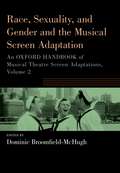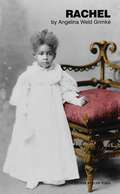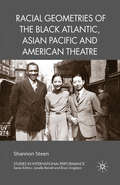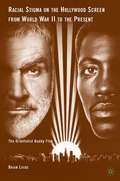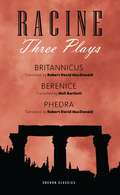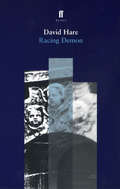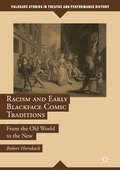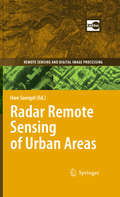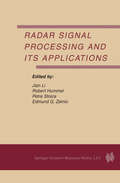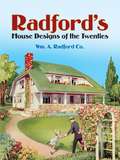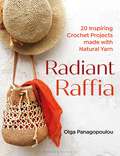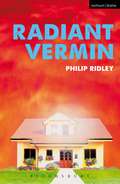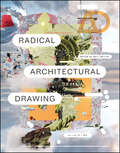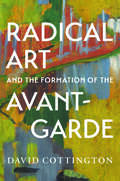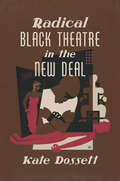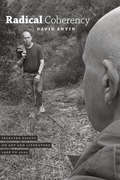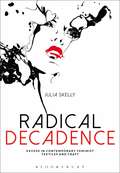- Table View
- List View
Race, Sexuality, and Gender and the Musical Screen Adaptation: An Oxford Handbook of Musical Theatre Screen Adaptations, Volume 2 (OXFORD HANDBOOKS SERIES)
by Dominic Broomfield-McHughHollywood's conversion to sound in the 1920s created an early peak in the film musical, following the immense success of The Jazz Singer. The opportunity to synchronize moving pictures with a soundtrack suited the musical in particular, since the heightened experience of song and dance drew attention to the novelty of the technological development. Until the near-collapse of the genre in the 1960s, the film musical enjoyed around thirty years of development, as landmarks such as The Wizard of Oz, Meet Me in St. Louis, Singin' in the Rain, and Gigi showed the exciting possibilities of putting musicals on the silver screen. The second of three volumes, Race, Sexuality, and Gender and the Musical Screen Adaptation: An Oxford Handbook, traces how the genre of the stage-to-screen musical has evolved, focusing in particular of issues of race, gender and sexuality. Enduringly popular adaptations such as Kiss Me Kate and Pal Joey are considered through the lens of identity, while several chapters consider how different adaptations of the same stage musical reflect shifting historical contexts. Together, the chapters incite lively debates about the process of adapting Broadway for the big screen and provide models for future studies. Volume I: The Politics of the Musical Theatre Screen Adaptation Volume II: Race, Sexuality, and Gender and the Musical Screen Adaptation Volume III: Stars, Studios, and the Musical Theatre Screen Adaptation
Race, Sexuality, and Gender and the Musical Screen Adaptation: An Oxford Handbook of Musical Theatre Screen Adaptations, Volume 2 (OXFORD HANDBOOKS SERIES)
Hollywood's conversion to sound in the 1920s created an early peak in the film musical, following the immense success of The Jazz Singer. The opportunity to synchronize moving pictures with a soundtrack suited the musical in particular, since the heightened experience of song and dance drew attention to the novelty of the technological development. Until the near-collapse of the genre in the 1960s, the film musical enjoyed around thirty years of development, as landmarks such as The Wizard of Oz, Meet Me in St. Louis, Singin' in the Rain, and Gigi showed the exciting possibilities of putting musicals on the silver screen. The second of three volumes, Race, Sexuality, and Gender and the Musical Screen Adaptation: An Oxford Handbook, traces how the genre of the stage-to-screen musical has evolved, focusing in particular of issues of race, gender and sexuality. Enduringly popular adaptations such as Kiss Me Kate and Pal Joey are considered through the lens of identity, while several chapters consider how different adaptations of the same stage musical reflect shifting historical contexts. Together, the chapters incite lively debates about the process of adapting Broadway for the big screen and provide models for future studies. Volume I: The Politics of the Musical Theatre Screen Adaptation Volume II: Race, Sexuality, and Gender and the Musical Screen Adaptation Volume III: Stars, Studios, and the Musical Theatre Screen Adaptation
Rachel (Oberon Modern Plays)
by Angelina Weld GrimkéToday, we colored men and women, everywhere - are up against it... In the South, they make it as impossible as they can for us to get educated. In the North, they make a pretence of liberality; they give us the ballot and a good education, and then snuff us out. Each year, the problem just to live, gets more difficult to solve.' The first play by an African American woman ever produced professionally. The European premiere – and the world's first production for nearly 100 years – of Rachel is directed by exciting young director Ola Ince, as part of Black History Month. Rachel is a young, educated, middle-class woman. But she is born into an African-American family in the early 20th century – a world in which ignorance and violence prevail. While her family and neighbours find different ways to survive, Rachel's dreams of getting married and becoming a mother collide with the tragic events of her family’s past as she confronts the harsh reality of a racist world. Written exactly midway between the American Civil War and the end of slavery, and the explosion of Civil Rights in the 1960s, this hauntingly beautiful and profoundly shocking play still asks urgent questions for today.
Racial Geometries of the Black Atlantic, Asian Pacific and American Theatre (Studies in International Performance)
by Shannon SteenAn exciting new work on how black and Asian racial structures were woven together within US theatrical practices in the run up to the Second World War, Steen uses this history to model how we might use performance histories to more carefully assess how racial formation occurs on the boundaries between racial groups in an international context.
Racial Stigma on the Hollywood Screen from World War II to the Present: The Orientalist Buddy Film
by Brian LockeRacial Stigma on the Hollywood Screen from WWII to the Present charts how the dominant white and black binary of American racial discourse influences Hollywood s representation of the Asian. The Orientalist buddy film draws a scenario in which two buddies, one white and one black, transcend an initial hatred for one another by joining forces against a foreign Asian menace. Alongside an analysis of multiple genres of film, Brian Locke argues that this triangulated rendering of race ameliorates the longstanding historical contradiction between U.S. democratic ideals and white America s persistent domination over blacks.
Racine: Berenice, Phèdre, Britannicus (Oberon Classics)
by Jean Racine Robert David MacDonald Neil BartlettIncludes the plays Britannicus, Phedra and BereniceJean Racine is the greatest tragedian of the French seventeenth century, using its strict rules and conventions to tell stories of overwhelming passion and cruelty.This volume brings together three of his greatest plays. Britannicus, the earliest, is set in the court of the young Emperor Nero, and in an atmosphere seething with erotic tension, documents the power-struggles surrounding the birth of a legendary despot. Berenice probes the hearts of two lovers as they are torn apart amidst the splendours of Imperial Rome, and in Phedra, the most famous of the three, a woman betrayed by her own desires descends into a personal hell of shame, guilt and remorse. These classic versions, by two of the country's most distinguished director-translators, prove that Racine is far from untranslatable; they offer blisteringly effective poetry, urgent plotting and powerhouse roles for both actors and actresses.
Racing Demon
by David HareHow do you fight without hate?Racing Demon reveals the struggle of four clergymen to make sense of their mission. David Hare's play opened at the National Theatre, London, in 1990 to universal acclaim, and won four awards as Play of the Year. Racing Demon was the first part of David Hare's trilogy of plays about British institutions; Murmuring Judges and The Absence of War completed the trilogy.
Racism and Early Blackface Comic Traditions: From the Old World to the New (Palgrave Studies in Theatre and Performance History)
by Robert HornbackThis book traces blackface types from ancient masks of grinning Africans and phallus-bearing Roman fools through to comedic medieval devils, the pan-European black-masked Titivillus and Harlequin, and racial impersonation via stereotypical 'black speech' explored in the Renaissance by Lope de Vega and Shakespeare. Jim Crow and antebellum minstrelsy recycled Old World blackface stereotypes of irrationality, ignorance, pride, and immorality. Drawing upon biblical interpretations and philosophy, comic types from moral allegory originated supposedly modern racial stereotypes. Early blackface traditions thus spread damning race-belief that black people were less rational, hence less moral and less human. Such notions furthered the global Renaissance’s intertwined Atlantic slave and sugar trades and early nationalist movements. The latter featured overlapping definitions of race and nation, as well as of purity of blood, language, and religion in opposition to 'Strangers'. Ultimately, Old World beliefs still animate supposed 'biological racism' and so-called 'white nationalism' in the age of Trump.
Racism and Early Blackface Comic Traditions: From the Old World to the New (Palgrave Studies in Theatre and Performance History)
by Robert HornbackThis book traces blackface types from ancient masks of grinning Africans and phallus-bearing Roman fools through to comedic medieval devils, the pan-European black-masked Titivillus and Harlequin, and racial impersonation via stereotypical 'black speech' explored in the Renaissance by Lope de Vega and Shakespeare. Jim Crow and antebellum minstrelsy recycled Old World blackface stereotypes of irrationality, ignorance, pride, and immorality. Drawing upon biblical interpretations and philosophy, comic types from moral allegory originated supposedly modern racial stereotypes. Early blackface traditions thus spread damning race-belief that black people were less rational, hence less moral and less human. Such notions furthered the global Renaissance’s intertwined Atlantic slave and sugar trades and early nationalist movements. The latter featured overlapping definitions of race and nation, as well as of purity of blood, language, and religion in opposition to 'Strangers'. Ultimately, Old World beliefs still animate supposed 'biological racism' and so-called 'white nationalism' in the age of Trump.
Radar Remote Sensing of Urban Areas (Remote Sensing and Digital Image Processing #15)
by Uwe SoergelOne of the key milestones of radar remote sensing for civil applications was the launch of the European Remote Sensing Satellite 1 (ERS 1) in 1991. The platform carried a variety of sensors; the Synthetic Aperture Radar (SAR) is widely cons- ered to be the most important. This active sensing technique provides all-day and all-weather mapping capability of considerably ?ne spatial resolution. ERS 1 and its sister system ERS 2 (launch 1995) were primarily designed for ocean app- cations, but soon the focus of attention turned to onshore mapping. Examples for typical applications are land cover classi?cation also in tropical zones and mo- toring of glaciers or urban growth. In parallel, international Space Shuttle Missions dedicated to radar remote sensing were conducted starting already in the 1980s. The most prominent were the SIR-C/X-SAR mission focussing on the investigation of multi-frequency and multi-polarization SAR data and the famous Shuttle Radar Topography Mission (SRTM). Data acquired during the latter enabled to derive a DEM of almost global coverage by means of SAR Interferometry. It is indispe- ableeventodayandformanyregionsthebestelevationmodelavailable. Differential SAR Interferometry based on time series of imagery of the ERS satellites and their successor Envisat became an important and unique technique for surface defor- tion monitoring. The spatial resolution of those devices is in the order of some tens of meters.
Radar Signal Processing and Its Applications
by Jian Jian Li Robert Hummel Petre Stoica Edmund G. ZelnioRadar Signal Processing and Its Applications brings together in one place important contributions and up-to-date research results in this fast-moving area. In twelve selected chapters, it describes the latest advances in architectures, design methods, and applications of radar signal processing. The contributors to this work were selected from the leading researchers and practitioners in the field. This work, originally published as Volume 14, Numbers 1-3 of the journal, Multidimensional Systems and Signal Processing, will be valuable to anyone working or researching in the field of radar signal processing. It serves as an excellent reference, providing insight into some of the most challenging issues being examined today.
Radford's House Designs of the Twenties
by Wm. A. Radford Co.Created as an aid to architects, carpenters, and builders, this Radford Architectural Company of Chicago catalog was also welcomed by future home owners. Included are such houses as the Bixby, a two-bedroom bungalow, the Coventry, a charming Dutch Colonial with three bedrooms and other accommodations, and more. 189 black-and-white illustrations.
Radiant Raffia: 20 Inspiring Crochet Projects Made With Natural Yarn
by Olga PanagopoulouLearn how to crochet 20 beautiful objects in raffia from bags, hats and belts to cushions, vases and table decorations.Get your hooks ready for a crochet book which brings the warmth of summer all year round. Patterns, charts and stunning photography are intertwined to create an inspiring atmosphere where the land, sea, textures and colours of the Greek islands work in harmony with the materials and techniques. Through step-by-step instructions discover 20 beautiful projects which show you how you can make stylish items which are 100% plant-based and eco-friendly. Mindful and relaxing, enjoy crocheting with raffia to create lovely gifts for friends and family or fashionable summer-inspired pieces to keep for yourself. Radiant Raffia is the essential modern guide to this must-have accessory.
Radiant Raffia: 20 Inspiring Crochet Projects Made With Natural Yarn
by Olga PanagopoulouLearn how to crochet 20 beautiful objects in raffia from bags, hats and belts to cushions, vases and table decorations.Get your hooks ready for a crochet book which brings the warmth of summer all year round. Patterns, charts and stunning photography are intertwined to create an inspiring atmosphere where the land, sea, textures and colours of the Greek islands work in harmony with the materials and techniques. Through step-by-step instructions discover 20 beautiful projects which show you how you can make stylish items which are 100% plant-based and eco-friendly. Mindful and relaxing, enjoy crocheting with raffia to create lovely gifts for friends and family or fashionable summer-inspired pieces to keep for yourself. Radiant Raffia is the essential modern guide to this must-have accessory.
Radiant Vermin (Modern Plays)
by Philip RidleyI feel this . . . thing inside me. Just here. Next to my heart. It's small. The size of sparrow. I don't know what it looks like. But I know it's got claws because it scratches. And I imagine it to be dark blue - mauve almost - like the veins on my mum's hands. I hear it talking. Its voice is high pitched and screeching. It's talking about all the things we've done.A wickedly comic satire about a young couple offered a way out of the housing crisis, and just how far they're prepared to go for it.Ollie and Jill want to tell you about their dream home. Some of the things they did to get it, you might find shocking. But they want you to know they did it all for their baby . . .A hilarious and outrageous black comedy from internationally acclaimed 'master of modern myth' (Guardian) Philip Ridley. Playful, provocative and viciously sharp, Radiant Vermin is a meditation on how far we will go to satisfy our materialistic greed.The play received its world premiere on 10 March 2015 at Soho Theatre, London.
The Radical Act of Listening: Making Documentary and Investigative Theatre
by KJ SanchezThe Radical Act of Listening: Making Documenatry and Investigative Theatre explores best practices in the field of Documentary and Investigative theatre and offers readers a how-to guide for making their own work, written by a leading practitioner in the field.This book looks at how listening can radically bring about change through documentary and investigative theatre. It examines the mechanics and value of listening and how theatre practitioners can use these skills to create theatre. What does it mean to really listen, especially during a time when everyone is shouting? Can we listen without an agenda? Can we take what we hear and find ethical ways to share it with others so that we capture nuance, complexity, contradiction, i.e., all things human? In exploring these questions, author KJ Sanchez shares conversations with peers and fellow artists who work in the fields of interview-based and non-fiction art practices, to look at what it takes to be a great listener and a great theatre maker.Featuring key artists, themes, and practices, this book is written for students and practitioners interested in creating documentary and investigative theatre, as well as other interview-based artforms.
The Radical Act of Listening: Making Documentary and Investigative Theatre
by KJ SanchezThe Radical Act of Listening: Making Documenatry and Investigative Theatre explores best practices in the field of Documentary and Investigative theatre and offers readers a how-to guide for making their own work, written by a leading practitioner in the field.This book looks at how listening can radically bring about change through documentary and investigative theatre. It examines the mechanics and value of listening and how theatre practitioners can use these skills to create theatre. What does it mean to really listen, especially during a time when everyone is shouting? Can we listen without an agenda? Can we take what we hear and find ethical ways to share it with others so that we capture nuance, complexity, contradiction, i.e., all things human? In exploring these questions, author KJ Sanchez shares conversations with peers and fellow artists who work in the fields of interview-based and non-fiction art practices, to look at what it takes to be a great listener and a great theatre maker.Featuring key artists, themes, and practices, this book is written for students and practitioners interested in creating documentary and investigative theatre, as well as other interview-based artforms.
Radical Architectural Drawing (Architectural Design)
There is a newfound interest in architectural drawing. Some of the most forward-looking architects worldwide are reinventing it to discover the radical possibilities of contemporary architecture as a rich mix of the virtual and the actual. Architectural drawing is adapting to compensate for these new changes to the discipline, and is being used to speculate on new paradigms of space and representation. This AD seeks to showcase the architects who are pushing the envelope of drawing in extraordinary ways, and their insights into architecture&’s future spatial dexterity. The issue is built around an international group of architects involved in an ongoing KU Leuven Faculty of Architecture international drawing research project, who are creating new drawing methodologies in new and exciting realms. Their projects are written about from the perspective of architectural representation by critics and commentators from across the globe, illustrating a cornucopia of graphic verve and talent in this highly contemporary and thought-provoking issue. Contributors: Aaron Betsky, Penelope Haralambidou, Ulrika Karlsson, Michael McGarry, Nicholas de Monchaux, Ricardo de Ostos, Alberto Pérez-Gómez, Peter Salter, Chris L Smith, Wolfgang Tschapeller, Sarah de Villiers, Robin Wilson, and Jason Young. Drawings by: Bryan Cantley, Nat Chard, Peter Cook, Riet Eeckhout, CJ Lim, Perry Kulper, Metis (Mark Dorrian and Adrian Hawker), Shaun Murray, Smout Allen, Neil Spiller, Nada Subotincic, Michael Webb, Mark West, and Michael Young.
Radical Art and the Formation of the Avant-Garde
by David CottingtonAn authoritative re-definition of the social, cultural and visual history of the emergence of the “avant-garde” in Paris and London Over the past fifty years, the term "avant-garde" has come to shape discussions of European culture and modernity, ubiquitously taken for granted but rarely defined. This ground-breaking book develops an original and searching methodology that fundamentally reconfigures the social, cultural, and visual context of the emergence of the artistic avant-garde in Paris and London before 1915, bringing the material history of its formation into clearer and more detailed focus than ever before. Drawing on a wealth of disciplinary evidence, from socio-economics to histories of sexuality, bohemia, consumerism, politics, and popular culture, David Cottington explores the different models of cultural collectivity in, and presumed hierarchies between, these two focal cities, while identifying points of ideological influence and difference between them. He reveals the avant-garde to be at once complicit with, resistant to, and a product of the modernizing forces of professionalization, challenging the conventional wisdom on this moment of cultural formation and offering the means to reset the terms of avant-garde studies.
Radical Black Theatre in the New Deal (The John Hope Franklin Series in African American History and Culture)
by Kate DossettBetween 1935 and 1939, the United States government paid out-of-work artists to write, act, and stage theatre as part of the Federal Theatre Project (FTP), a New Deal job relief program. In segregated "Negro Units" set up under the FTP, African American artists took on theatre work usually reserved for whites, staged black versions of "white" classics, and developed radical new dramas. In this fresh history of the FTP Negro Units, Kate Dossett examines what she calls the black performance community—a broad network of actors, dramatists, audiences, critics, and community activists—who made and remade black theatre manuscripts for the Negro Units and other theatre companies from New York to Seattle. Tracing how African American playwrights and troupes developed these manuscripts and how they were then contested, revised, and reinterpreted, Dossett argues that these texts constitute an archive of black agency, and understanding their history allows us to consider black dramas on their own terms. The cultural and intellectual labor of black theatre artists was at the heart of radical politics in 1930s America, and their work became an important battleground in a turbulent decade.
Radical Coherency: Selected Essays on Art and Literature, 1966 to 2005
by David Antin“We got to talking”—so David Antin begins the introduction to Radical Coherency, embarking on the pursuit that has marked much of his breathless, brilliantly conversational work. For the past forty years, whether spoken under the guise of performance artist or poet, cultural explorer or literary critic, Antin’s innovative observations have helped us to better understand everything from Pop to Postmodernism. Intimately wedded to the worlds of conceptual art and poetics, Radical Coherency collects Antin’s influential critical essays and spontaneous, performed lectures (or “talk pieces”) for the very first time, capturing one of the most distinctive perspectives in contemporary literature. The essays presented here range from the first serious assessment of Andy Warhol published in a major art journal, as well as Antin’s provocative take on Clement Greenberg’s theory of Modernism, to frontline interventions in present debates on poetics and fugitive pieces from the ’60s and ’70s that still sparkle today—and represent a gold mine for art historians of the period. From John Cage to Allan Kaprow, Mark Rothko to Ludwig Wittgenstein, Antin takes the reader on an idiosyncratic, personal journey through twentieth-century culture with his trademark antiformalist panache—one thatwill be welcomed by any fan of this consummate trailblazer.
Radical Coherency: Selected Essays on Art and Literature, 1966 to 2005
by David Antin“We got to talking”—so David Antin begins the introduction to Radical Coherency, embarking on the pursuit that has marked much of his breathless, brilliantly conversational work. For the past forty years, whether spoken under the guise of performance artist or poet, cultural explorer or literary critic, Antin’s innovative observations have helped us to better understand everything from Pop to Postmodernism. Intimately wedded to the worlds of conceptual art and poetics, Radical Coherency collects Antin’s influential critical essays and spontaneous, performed lectures (or “talk pieces”) for the very first time, capturing one of the most distinctive perspectives in contemporary literature. The essays presented here range from the first serious assessment of Andy Warhol published in a major art journal, as well as Antin’s provocative take on Clement Greenberg’s theory of Modernism, to frontline interventions in present debates on poetics and fugitive pieces from the ’60s and ’70s that still sparkle today—and represent a gold mine for art historians of the period. From John Cage to Allan Kaprow, Mark Rothko to Ludwig Wittgenstein, Antin takes the reader on an idiosyncratic, personal journey through twentieth-century culture with his trademark antiformalist panache—one thatwill be welcomed by any fan of this consummate trailblazer.
Radical Coherency: Selected Essays on Art and Literature, 1966 to 2005
by David Antin“We got to talking”—so David Antin begins the introduction to Radical Coherency, embarking on the pursuit that has marked much of his breathless, brilliantly conversational work. For the past forty years, whether spoken under the guise of performance artist or poet, cultural explorer or literary critic, Antin’s innovative observations have helped us to better understand everything from Pop to Postmodernism. Intimately wedded to the worlds of conceptual art and poetics, Radical Coherency collects Antin’s influential critical essays and spontaneous, performed lectures (or “talk pieces”) for the very first time, capturing one of the most distinctive perspectives in contemporary literature. The essays presented here range from the first serious assessment of Andy Warhol published in a major art journal, as well as Antin’s provocative take on Clement Greenberg’s theory of Modernism, to frontline interventions in present debates on poetics and fugitive pieces from the ’60s and ’70s that still sparkle today—and represent a gold mine for art historians of the period. From John Cage to Allan Kaprow, Mark Rothko to Ludwig Wittgenstein, Antin takes the reader on an idiosyncratic, personal journey through twentieth-century culture with his trademark antiformalist panache—one thatwill be welcomed by any fan of this consummate trailblazer.
Radical Decadence: Excess in Contemporary Feminist Textiles and Craft
by Julia SkellyThis pioneering book explores the notion of 'radical decadence' as concept, aesthetic and lived experience, and as an analytical framework for the study of contemporary feminist textile art. Gendered discourses of decadence that perpetuate anxieties about women's power, consumption and pleasure are deconstructed through images of drug use, female sexuality and 'excessive' living, in artworks by several contemporary textile artists including Orly Cogan, Tracey Emin, Allyson Mitchell, and Rozanne Hawksley.Perceptions of decadence are invariably bound to the negative connotations of decay and degradation, particularly with regard to the transgression of social norms related to femininity and the female body. Excessive consumption by women has historically been represented as grotesque, and until now, women's pleasure in relation to drug and alcohol use has largely gone unexamined in feminist art history and craft studies. Here, representations of female consumption, from cupcakes to alcohol and cocaine, are opened up for critical discussion. Drawing on feminist and queer theories, Julia Skelly considers portrayals of 'bad girls' in artworks that explore female sexuality - performative pieces designed to subvert and exceed feminine roles. In this provocative book, decadence is understood not as a destructive force but as a liberating aesthetic.
Radical Decadence: Excess in Contemporary Feminist Textiles and Craft
by Julia SkellyThis pioneering book explores the notion of 'radical decadence' as concept, aesthetic and lived experience, and as an analytical framework for the study of contemporary feminist textile art. Gendered discourses of decadence that perpetuate anxieties about women's power, consumption and pleasure are deconstructed through images of drug use, female sexuality and 'excessive' living, in artworks by several contemporary textile artists including Orly Cogan, Tracey Emin, Allyson Mitchell, and Rozanne Hawksley.Perceptions of decadence are invariably bound to the negative connotations of decay and degradation, particularly with regard to the transgression of social norms related to femininity and the female body. Excessive consumption by women has historically been represented as grotesque, and until now, women's pleasure in relation to drug and alcohol use has largely gone unexamined in feminist art history and craft studies. Here, representations of female consumption, from cupcakes to alcohol and cocaine, are opened up for critical discussion. Drawing on feminist and queer theories, Julia Skelly considers portrayals of 'bad girls' in artworks that explore female sexuality - performative pieces designed to subvert and exceed feminine roles. In this provocative book, decadence is understood not as a destructive force but as a liberating aesthetic.
